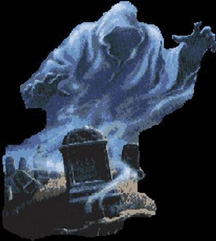
Volume XVII, Issue 43 ~ October 22 - October 28, 2009
Home \\ Correspondence \\ from the Editor \\ Submit a Letter \\ Classifieds \\ Contact Us
Dining Guide \\ Home & Garden Guide \\ Archives \\ Distribution Locations \\ Advertising
![]()

How to Tell — or Write — a Spooky Story

![]() Nothing goes with Halloween like a spooky story. Spooky stories can be told any time of year, of course, but the early darkness of late October is particularly conducive to having your socks scared off.
Nothing goes with Halloween like a spooky story. Spooky stories can be told any time of year, of course, but the early darkness of late October is particularly conducive to having your socks scared off.
But darkness alone won’t put the scare in a story. For that you need conviction and craft.
Conviction: If your story doesn’t send a shiver up your spine, it won’t send one up anyone else’s. You have to believe every story you tell — at least a little bit.
Craft: Every story wants a plot, and a plot wants three things: a beginning, a middle and an end.
In the Beginning
Be subtle, not overt. Begin the story like you would any other, like it was about a trip to the grocery store. Set the scene and describe the characters. If your listeners or readers don’t know anything about the people in the story, they won’t care what happens to them. Give a few key details — like the lines in a coloring book — and let them fill in the rest.
In the Middle
The middle is when things start heating up. Events go from good to bad or from bad to worse, dragging your characters along behind (or driving them in front). This happens a little differently, depending on what kind of story you’re telling. There are stories in which living people end up as ghosts, stories in which living people are haunted by ghosts and stories in which living people are haunted by living people (who often have hooks for hands).
If your characters are being haunted, take care not to reveal too much too soon. Throw a few mysterious details at your listeners or readers, again letting them fill in the details. Remember that each of us knows what scares us best; people are fully capable of scaring themselves silly if pointed in the right direction.
Slow down as you near your climax. Let every word sink in. Give your readers or listeners plenty of time to scare themselves with details: the ones you give and the ones they imagine.
The End
Slowly bring your story to a boil — a point of no return, for your characters and listeners alike. Your characters get their heads chopped off or find the corpses of their loved ones or spy hooks hanging from their door handles and throw themselves off cliffs or down a well.
Only now can you be overt and get away with it, and then only if you want your audience to scream and leap out of their seats. In prose or person, you can jump or shout or clap your hands or grab a listener. Or you can end your story as slowly and subtly as it began.
The surprise ending lets your readers or listeners release all the fear they’ve been building up inside; the quiet ending sends them to bed with it. It also keeps kids awake for hours, or gives them nightmares that last well into adulthood, so be prepared to reap what you sow.
Stuck for an idea? The Maryland Ghost & Spirit Association’s website (www.marylandghosts.com) describes 232 hauntings in the state, organized by county.
–from Bay Weekly’s files
© COPYRIGHT 2009 by New Bay Enterprises, Inc. All rights reserved.